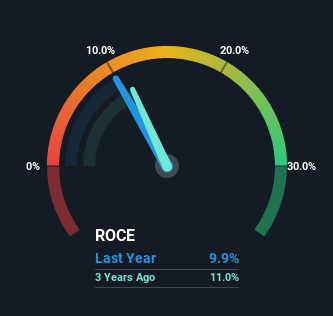- Hong Kong
- /
- Metals and Mining
- /
- SEHK:1090
Da Ming International Holdings (HKG:1090) Has More To Do To Multiply In Value Going Forward
If you're looking for a multi-bagger, there's a few things to keep an eye out for. In a perfect world, we'd like to see a company investing more capital into its business and ideally the returns earned from that capital are also increasing. Put simply, these types of businesses are compounding machines, meaning they are continually reinvesting their earnings at ever-higher rates of return. In light of that, when we looked at Da Ming International Holdings (HKG:1090) and its ROCE trend, we weren't exactly thrilled.
Return On Capital Employed (ROCE): What Is It?
For those that aren't sure what ROCE is, it measures the amount of pre-tax profits a company can generate from the capital employed in its business. Analysts use this formula to calculate it for Da Ming International Holdings:
Return on Capital Employed = Earnings Before Interest and Tax (EBIT) ÷ (Total Assets - Current Liabilities)
0.099 = CN¥541m ÷ (CN¥14b - CN¥8.9b) (Based on the trailing twelve months to June 2022).
Therefore, Da Ming International Holdings has an ROCE of 9.9%. On its own, that's a low figure but it's around the 12% average generated by the Metals and Mining industry.
Check out our latest analysis for Da Ming International Holdings

While the past is not representative of the future, it can be helpful to know how a company has performed historically, which is why we have this chart above. If you want to delve into the historical earnings, revenue and cash flow of Da Ming International Holdings, check out these free graphs here.
What Can We Tell From Da Ming International Holdings' ROCE Trend?
There are better returns on capital out there than what we're seeing at Da Ming International Holdings. The company has consistently earned 9.9% for the last five years, and the capital employed within the business has risen 45% in that time. Given the company has increased the amount of capital employed, it appears the investments that have been made simply don't provide a high return on capital.
On a separate but related note, it's important to know that Da Ming International Holdings has a current liabilities to total assets ratio of 62%, which we'd consider pretty high. This effectively means that suppliers (or short-term creditors) are funding a large portion of the business, so just be aware that this can introduce some elements of risk. Ideally we'd like to see this reduce as that would mean fewer obligations bearing risks.
What We Can Learn From Da Ming International Holdings' ROCE
In conclusion, Da Ming International Holdings has been investing more capital into the business, but returns on that capital haven't increased. And investors appear hesitant that the trends will pick up because the stock has fallen 41% in the last five years. All in all, the inherent trends aren't typical of multi-baggers, so if that's what you're after, we think you might have more luck elsewhere.
Da Ming International Holdings does have some risks, we noticed 2 warning signs (and 1 which is significant) we think you should know about.
While Da Ming International Holdings may not currently earn the highest returns, we've compiled a list of companies that currently earn more than 25% return on equity. Check out this free list here.
New: Manage All Your Stock Portfolios in One Place
We've created the ultimate portfolio companion for stock investors, and it's free.
• Connect an unlimited number of Portfolios and see your total in one currency
• Be alerted to new Warning Signs or Risks via email or mobile
• Track the Fair Value of your stocks
Have feedback on this article? Concerned about the content? Get in touch with us directly. Alternatively, email editorial-team (at) simplywallst.com.
This article by Simply Wall St is general in nature. We provide commentary based on historical data and analyst forecasts only using an unbiased methodology and our articles are not intended to be financial advice. It does not constitute a recommendation to buy or sell any stock, and does not take account of your objectives, or your financial situation. We aim to bring you long-term focused analysis driven by fundamental data. Note that our analysis may not factor in the latest price-sensitive company announcements or qualitative material. Simply Wall St has no position in any stocks mentioned.
About SEHK:1090
Da Ming International Holdings
Processes, distributes, and sells stainless steel and carbon steel products and components, and equipment in the Mainland China.
Good value with very low risk.
Market Insights
Community Narratives



